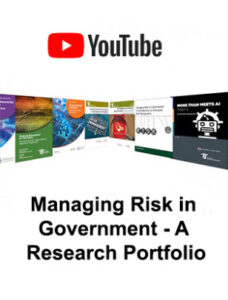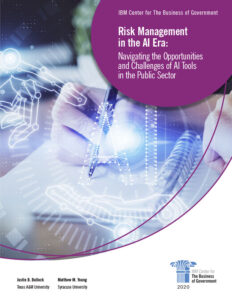Moving the Conversation from Risk Management to Value Management – 2019
 This session explored how risk management contributes to the ultimate goal of any organization: the delivery of maximum stakeholder value. Capturing the true value of ERM requires integration of results sought, resources allocated, and risks accepted and managed through a portfolio management process across the entire organization. Panelists shared their experiences, including challenges and end results.
This session explored how risk management contributes to the ultimate goal of any organization: the delivery of maximum stakeholder value. Capturing the true value of ERM requires integration of results sought, resources allocated, and risks accepted and managed through a portfolio management process across the entire organization. Panelists shared their experiences, including challenges and end results.
Speakers: Tom Brandt, Chief Risk Officer, IRS; Ken Fletcher, President, AFERM
Download2019 ERM Survey Results
 Speaker: David Fisher, Guidehouse
Speaker: David Fisher, Guidehouse
The Path to ERM at the Largest Charitable Organization in the U.S. – 2019
 The YMCA’s path to ERM was both a learning experience and an example of real success. Join Nancy Owens for a discussion of ERM at the YMCA, including how their thinking evolved about ERM over time, how they corralled their risks, how -they identify and manage risks, what their governance looks like and what role the audit committee plays, and how they filter on new priorities, all in the context of a not-for-profit organization.
The YMCA’s path to ERM was both a learning experience and an example of real success. Join Nancy Owens for a discussion of ERM at the YMCA, including how their thinking evolved about ERM over time, how they corralled their risks, how -they identify and manage risks, what their governance looks like and what role the audit committee plays, and how they filter on new priorities, all in the context of a not-for-profit organization.
Speaker: Nancy Owens, Senior Vice-President & Chief Financial Officer, YMCA of the USA
DownloadMastering Risk: Ways To Advance Enterprise Risk Management Across Government
This Resource has been removed due to a citation error.
A Conversation with Tom Brandt, Chief Risk Officer, U.S. Internal Revenue Service
What are benefits of pursuing enterprise risk management? How can risk management enhance agency decision-making? What is the mission of the Association for Federal Enterprise Risk Management (AFERM)? Join host Michael Keegan as he explores these questions and more with our very special guest, Tom Brandt, Chief Risk Officer, at the US Internal Revenue Service (IRS).
On Managing Risk in Government – A Research Portfolio

Risk is everywhere.
It is a condition of existence and government agencies aren’t immune from the slings and arrows of uncertainty. Risk takes many forms and continue to morph and transform with the pace of technology and the reality interconnectedness. It is a leadership imperative for government executives to mitigate the potency of uncertainty by managing the realities of risk and the IBM Center can help them…mitigate risk and make better decisions. Tackling risks requires the right tools and recognized best practices. Dr. Karen Hardy’s report outlines the fundamentals of enterprise risk management ERM in government…answering the how to and the why not? The first step in tackling risk is defining it and it isn’t always negative. Risk can present opportunities. Government Leaders can redefine risk as “uncertainty that matters” and Dr. Doug Webster and Tom Stanton can show you how… outlining practical steps to improving decision making using ERM. Many federal programs are at risk unable or incapable to achieving missions mitigating program risk is key to making government work better. Prof Donald Kettl report, provides a guide of steps risky federal programs can take to manage risk, improve results. Whether you face …. Integrity Risk Financial Risk Cyber Risks Or, risks associated with technological breakthroughs and disruptions…
This video provides an overview of many IBM Center for The Business of Government resources on risk.
Risk Management in the AI Era: Navigating the Opportunities and Challenges of AI Tools in the Public Sector
 Artificial Intelligence (AI) has moved into the mainstream of businesses and government.
Artificial Intelligence (AI) has moved into the mainstream of businesses and government.
Business leaders are rushing to take advantages of the benefits that can be brought to a wide array of industries to help increase productivity. Government leaders are also moving forward, but with appropriate caution. When considering the use and application of AI related technologies, government leaders weigh different factors than their private sector counterparts. Whether it is deploying self-driving electric trolleys in a city or retrofitting city streetlights with sensors to make them “smarter,” these leaders must address issues of accountability, transparency, ethics, equity, common good, effectiveness, efficiency, managerial capacity, and political legitimacy.
The report authors put forth a threefold strategy to assist government leaders and public managers with how best to approach using AI, which includes:
- reviews of prior federal government studies on the use and application of AI. These reports reflect a number of important issues for agencies and stakeholders to consider as they begin incorporating AI; the studies also highlight the government’s broad risk management approach to AI
- a risk management framework for when and how government can and should consider using AI tools, how to use these tools, and which organizational tasks and decisions may benefit from the use of AI
- case studies of two innovative uses of AI tools to help manage risks from local governments: the City of Syracuse, New York, and the City of Bryan, Texas.
The authors close with a list of practical guidelines for government action in using AI tools to improve the overall quality of governance, while incorporating similar tools into their overall risk management strategy.
The Value of Enterprise Risk Management to Federal Executives
This flyer outlines the value that Enterprise Risk Management (ERM) can provide to government leaders.
Getting Ahead of Risks Before They Become Government Failures
An Imperative for Agency Leaders to Embrace Enterprise Risk Management
Several recent reports and studies have detailed a range of worsening trends and developments that are creating an increased risk for significant government failure. Many of the reports offer recommendations for action by Congress and the Administration. However, they do not go as far to suggest and recognize what agency leaders can do, and in many cases are doing, to help address these challenges. This paper, from the Senior Executives Association (SEA) and the Association for Federal Enterprise Risk Management (AFERM), aims to highlight how agency leaders can use enterprise risk management to reduce the risk of government failure while increasing the likelihood for the successful delivery of agency missions.



